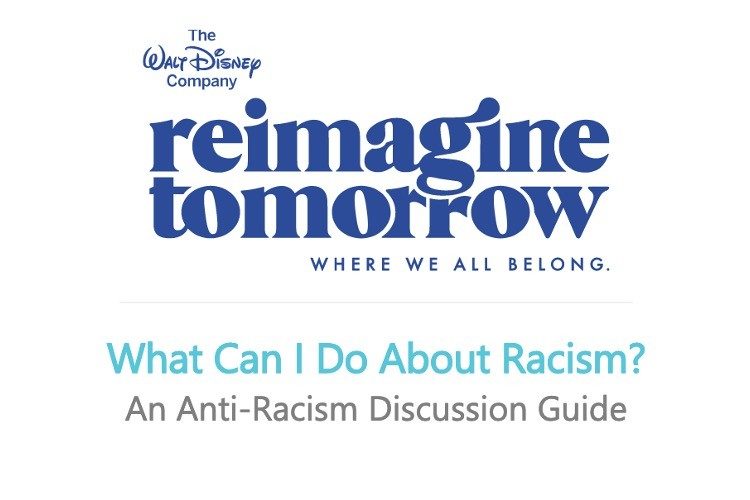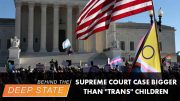
Walt Disney Co. has reportedly joined corporate America’s rush toward critical race theory, teaching staff that America is rooted in “systemic racism” and that white employees must show special deference to their black colleagues.
Disney training materials obtained by journalist Christopher Rufo include a 22-page report called “Reimagine Tomorrow” that urges workers to recognize their “white privilege” and become proactive “allies” to the black community.
[wpmfpdf id=”126978″ embed=”1″ target=””]The first part of the two-part report, “Allyship for Race Consciousness,” offers three steps to promote racial justice.
The first step, “Learning,” specifies that white employees should not rely on their black colleagues to educate them about racial issues, because that would be “emotionally taxing.” Instead, workers need to read public posts by black authors to “understand the emotional complexity,” and proactively seek out black stories “that reflect success, joy, and creativity,” and then share and discuss the findings with their fellow white colleagues.
The next step, “Reflect,” asks white employees to recognize their privilege. White employees are told to “work through feelings of guilt, shame, and defensiveness to understand what is beneath them and what needs to be healed.” They must “listen with empathy [to] Black colleagues” and “not question or debate Black colleagues’ lived experience.” Disney specifies, for example, that the COVID-19 pandemic has disproportionately affected black people, as has police brutality, which Disney calls part of a “long history of systemic racism and transphobia.”
The final step, “Engage,” requires white employees to take action. Than includes being “accountable” and being “involved.” The guide asks to reject “colorblind ideologies and rhetoric,” e.g. “All Lives Matter,” or “I don’t see color.” It is considered “harmful and hurtful, as it is a form of erasing the real and specific ways racial identities affect lived experiences.” Employees are encouraged to contribute to the black community by consistently supporting black-owned businesses and/or volunteering for organizations that advance racial equity and justice, among other actions.
“Engage” calls for involvement in the racial-justice movement. On an individual level, white employees are expected to build empathy with black colleagues, listening and learning from them when they’re willing to share their experiences. What if one tries to avoid politicized conversations? The guide recommends against using statements such as “Let’s keep this conversation professional” or “politics don’t belong at work.” Brace yourself and listen.
When it comes to institutional involvement, the guide recommends that organizations recognize, praise, and promote black talent, and to report any instances of discrimination.
The Disney guide provides helpful educational links on the topic, such as articles and videos covering “white privilege” and a “racially just workplace.”
The second part of the report, called “What Can I Do About Racism?” is basically a four-part discussion guide, and states:
Anti-racism can begin here by increasing our awareness of the discrimination people of color face daily….
The problem is that systemic racism, or racism carried out by groups with power like societies, governments, businesses, and schools, benefits some people and harms others despite your personal beliefs….
This discussion guide will prepare you to have open dialogue about racism with your colleagues.
Don’t want to have a dialogue about racism or believe that racism doesn’t exist? Disney believes that it’s due to “implicit biases” and “microaggression” — both a part of your “unconscious racism.” Disney wants its workers to become “anti-racist,” and yet again outlines importance of “contributions” to black organizations and businesses, and also “standing up for others,” “who are being discriminated against” in both covert ways (not getting an invitation to lunch, for example), and overt ways (being talked over in a meeting, etc.) Disney doesn’t provide any instructions how to distinguish between racial and personal “injustices,” if a person is not invited or being talked over due to their skin color or for any other reason.
To avoid offending black co-workers, white staffers are told to “learn what to say and what not to say.” For example, “I pray/hope it changes soon” is a no-go. “I realize my discomfort is a fraction of what you’re feeling” is a good thing to say, per the discussion guide.
In conclusion, Disney explains that it strives to build “equity” rather than “equality” in the workplace: “Equality is a noble goal…. But we really need to be striving for equity, where we focus on the equality of the outcome, not the equality of the experience by taking individual needs and skills into account,” which is painfully reminiscent of the Marxist slogan, “From each according to his ability, to each according to his needs.”
Disney is far from alone in pushing critical race theory on its employees. Government agencies, school districts, and companies across the United States have adopted such programs. For instance, Coca-Cola had mandatory training in which employees were told to be “less white.”
President Joe Biden restored such training at the federal agencies immediately upon taking office in January when he rescinded a ban ordered by former President Donald Trump. Republican-controlled states, such as Idaho, Oklahoma, and Iowa, have taken steps in recent weeks to ban such teaching in their schools and universities.
Disney has recently been criticized for firing actress Gina Carano for her “politically incorrect” conservative opinions, and smearing some of its classic movies such as Dumbo and Peter Pan as racist.




